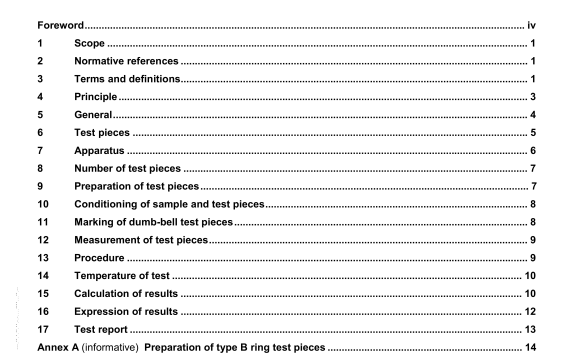BS ISO 00037 pdf download – ubber, vulcanized orthermoplastic —— Determination of tensile stress-strainproperties.
The repeatability and reproducibility of the method were calculated on the basis 01 ISO1TR 9272:2005. Onginal data were treated for outliers at the 5 % and 2 % significance level on the bas*s of the procedures described in ISOIIR 9272:2005.
B.2 Details of test programmes
B2.1 Two inter-laboratory test programmes (ITPs) were organized.
The first ITP in 2001 was as follows:
Three different compounds of NR, SBR and PDM were used for tensile tests. A test result fat this test method was the average or mean of five separate measurements of each of the properties as indicated below.
A total of 23 laboratories in eight countries participated in the programme.
The second 1W in 2002 was as follows:
One NR compound was used for tensile testing. The compound formulation was the same as the NR compound used in the first lIP.
A total of 17 laboratories in six countries participated in the programme.
The fully prepared rubber test pieces were sent to eadi laboratory for evaluation in both ITPs with type 1 precision.
B.2.2 The test properties to be measured were tensile strength at break (TSb). elongation at break (Eb), stress at 100% elongation (S1) and stress at 200 % elongation (s2).
B.2.3 Three types of dumb-bell, type 1, type 2 and type 1A, were tested
The type I was tested wrih two test lengths at 20 mm and 25 mm marked on them in the first ITP, but for the second ITP only test pieces with a test length of 25 mm were tested
C.1 General
This annex considers the performance of the different dumb-bell shapes. including the type 1A. that was measured through the FTP programmes. The type 1A dumb-bell Is a new addition to this International Standard, but it has been in use in Japan and other countries for many years
Interlaboratory tests showed mat the type 1 A dumb-bell has advantages over types 1 and 2 of better repeatability and, particularly, lower inddence of breaks outside the test length. Finite-element analysis demonstrated that the strain distribution in the type IA is more uniform, which probably accounts for its Improved performance.
The values of tensile properties determined with the type IA dumb-bell are very similar to those obtained with the type 1, but they cannot be expected to be identical in all cases.
The type 1A dumb.bell has similar overall dimensions to the type 1 and can be considered as an altemative. It has not replaced the type I because of the huge bank of data obtained and the long tradition with the latter dumb-bell.
C.2 Three variances for three-factor fully-nested experiments
In the comparison of the precision calculated in accordance with ISO/TR 9272:2005, lilt an Indicator of the variance between laboratories (q2). and the r Is an indicator of the total variance (at) • 2) for a particular laboratory, made up of the variance between the days (rib2) and the variance due to measurement errors (2). In order to analyse D2 and nj separately, it is enough to make an estimate of each component of the variance by the so-caNed three-factor fully-nested experiments described In ISO 5725-3.
The estimate was made for each component of the total variance in the measurements in the second ITP. The results are shown In Tables C.1 and C.2.
BS ISO 00037 pdf download – ubber, vulcanized orthermoplastic —— Determination of tensile stress-strainproperties
